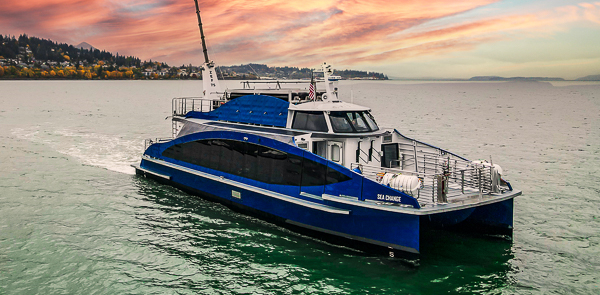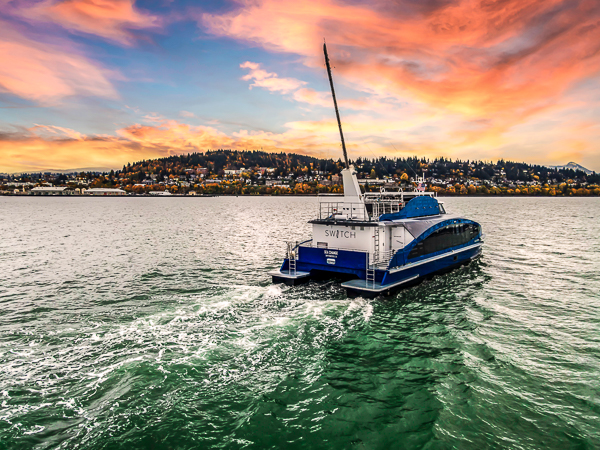AAM President & COO Ron Wille recently caught up with the Passenger Vessel Association’s FOGHORN Magazine discussing the Sea Change, our recently completed hydrogen fuel cell vessel. Read Ron’s article below, and learn more about how choosing the right builder for such a groundbreaking project is critical to its success.
If you have ever had the opportunity to read Michael Pollen’s book “Botany of Desire” you may learn an interesting botanical fact about apples. If you plant the seeds of an apple, like a Gala, Honeycrisp, or a Red Delicious, the offspring will look nothing like the parent, it will be a completely different variety and will most likely be inedible. You don’t eat apples planted from seeds. They must be grafted, cloned. Red Delicious apples were discovered in 1875 on Jesse Hiatt’s farm in Peru, Iowa. The Red Delicious apple you eat today is an exact clone of the one grown in Iowa in 1875. This makes the red delicious more prone and vulnerable to the untold generations of ever-changing insects that want to take a bite, making it harder for farmers to protect. About now, you are asking yourself, “What the heck do apples and insects have to do with building a hydrogen boat in the United States?” The answer is simple, change.
BACKGROUND
It all started with an idea. In 2014, San Francisco-based tour boat company Red and White Fleet approached Sandia National Laboratories to explore whether zero-emission, hydrogen fuel cell technology could be applied to a new vessel. Dr. Joe Pratt was working on fuel cell technology at Sandia and was assigned a task from his boss, talk to Tom Escher about putting fuel cells to work in boats. As Joe Pratt recounts, it all started with a single sentence on that call from Tom Escher, “Joe, you don’t understand. I don’t want to reduce pollution. I want zero pollution.” To provide an answer for Tom, Sandia and others, including the team at Escher’s Red and White Fleet partnered on the SF-BREEZE project (and other case studies) to examine the technical, regulatory, and economic feasibility of a high-speed passenger ferry powered solely by hydrogen fuel cells and its associated hydrogen fueling infrastructure within the context of the San Francisco Bay. Joe Pratt and Dr. Lennie Klebanoff led the charge for over three years. Ultimately, their research concluded that constructing and building such a vessel was theoretically possible.
“It all started with a single sentence, “Joe, you don’t understand. I don’t want to reduce pollution. I want zero pollution.”
Upon completion of the report and after reading the results, Escher remarked, “We can study this thing to death. We know it’s possible. We’ve got to build one and prove it.”
The team forged ahead. Joe Pratt and partners started Golden Gate Zero Emission Marine, now Zero Emissions Industries (ZEI)) using their own funds. The company applied, was awarded a $3 million grant from the California Air Resources Board (CARB), and began making the project a reality. The group and their partners began constructing a hydrogen fuel cell ferry, named initially the Water-Go-Round, locally in San Francisco Bay. Zero Emission Industries is a hydrogen technology company comprised of world-leading experts with proven track records. It provides the critical behind-the-scenes novel technology products that make it extremely simple for end users and OEMs/integrators to deploy clean energy hydrogen marine systems.
The Water-Go-Round (now called the Sea Change) project attracted the attention of an investor/purchaser, Switch E-Maritime. Switch purchased the ferry while it was still under construction. Switch is an impact investment platform focused on building the first fleet of exclusively zero-carbon maritime vessels. Their mission is to accelerate the decarbonization and energy transition of the US maritime sector.
This is when All American Marine became involved, and the partially constructed vessel was shipped to Bellingham for completion, integration, and outfitting. Building innovative and high-quality boats is All American Marine’s core competency. Welding, fabrication, design, and outfitting is what we do every day. On this project, working with such a large and diverse team to integrate the latest technological advances into our vessels highlights our strengths and capabilities as a shipyard. With the combined efforts and cooperation of All American Marine (builder), Incat-Crowther (structural designer), ZEI (hydrogen power designer), Hornblower (systems designer), BAE Systems (propulsion), Cummins (fuel cells), and many others with valuable expertise the project forged ahead and, one USCG approval at a time, and the vessel was constructed.
During the course of the Sea Change project, our team experienced challenges related to “change” on many levels. This included everything from the conceptual idea of using hydrogen propulsion to adhering to international codes such as the IMO’s International Code of Safety for Ship Using Gases or Other Low-flashpoint Fuels (IGF code), the agreements leading to a USCG design basis letter, the naval architectural design, to the building process, to the systems integration, to the fueling, to sea trials, and onto the final approval. It’s been a challenging process full of change. It’s also been a process that All American Marine is proud to have been a critical participant due to its complexity and the significance of this vessel for the future.
What has been learned about hydrogen vessels during the construction of the Sea Change? First, choose a builder and a team with the experience to ask the right questions. A team with vision, patience, an open mindset, flexibility, and willingness to learn, will be a tremendous asset. A builder with a lower estimated cost and less experience at the start will not likely be less expensive when the project is finished.
The project started in California at a reputable repair facility hired for a new vessel build. The project was moved to the All American Marine (AAM) facility for various reasons, not the least of which was our decades of experience building innovative and custom boats. It was also beneficial that at AAM, we had a recent experience building and outfitting previous hybrid Li-ion battery-powered vessels that used many of the same BAE Systems propulsion components. On the Sea Change, BAE Systems supplied the 300-kW traction motors and energy management systems that propel the vessel using the energy from the hydrogen fuel cells. BAE has both the proven technology and experience as a propulsion integrator. While this technology is new to the maritime industry, BAE has been delivering electric and fuel cell-powered propulsion for over 10 years, so there is assurance in the system’s safety, reliability, and performance.
Cummins supplied the hydrogen fuel cells. Cummins believes in hydrogen’s viability as our next primary energy source. They are another example of a well-known reputable company pivoting, adapting to change, and going all-in on hydrogen. Cummins and other hydrogen producers will aim to create future hydrogen via 100% renewable sources. As projects such as this move forward, demand for hydrogen will increase, and this fuel’s development and distribution will be further streamlined and clean, becoming a genuinely net zero energy resource.
Another critical lesson is that USCG regulatory approvals, such as hazardous area approvals, will take longer than a traditional vessel build. It is essential to budget extra time and resources accordingly. The USCG certainly provided ample resources, much more than a typical project. Since they are tasked with minimizing and eliminating hazards in the marine industry, it is understandable they are cautious and extremely thorough in vetting out the application of hydrogen technology in vessels. However, this was a challenging, cutting-edge project, and decisions came only after vetting, which impacted the project schedule. Typically, governments and regulators attempt to keep pace with technology, but often by the time they understand and approve the technology, the product has already morphed or changed. Many of the decisions incorporated into the design and construction of the Sea Change were made to accommodate and ease the regulatory approval process. It was still a significant undertaking and accomplishment to obtain approval. Now that an initial path has been blazed, a framework is in place that certainly should streamline the process moving forward.

The USCG reviewed and ultimately approved the project in accordance with its standard policies. Their hard work and dedication were greatly appreciated. However, the project was complicated, and the review process was slower than desired by private industry. Notably, this vessel is the first of its kind, and additional time certainly added to the overall costs.
In closing, there will be no one-size-fits-all solution for replacing the internal combustion engine. However, hydrogen fuel cell technology will likely leapfrog both traditional diesel and hybrid-electric propulsion methods as one of the most beneficial for maritime applications. We see this pivot for several reasons, but the main reason is that hydrogen is transportable and has exceptionally high energy density.
- Hydrogen has more power and weighs significantly less than other forms of energy. One gallon of diesel (7.1 pounds) has slightly less energy than one kilogram of hydrogen (2.2 pounds).
- Li-ion batteries are roughly 50 times as heavy as diesel fuel. This makes it difficult to go far (or fast) in a boat running on batteries. They will work well on numerous applications and particularly well for slower vessels on shorter runs, vessels that can handle their additional battery weight.
- On a pound-for-pound basis, hydrogen has nearly 3 times the energy of diesel fuel and can also be used more efficiently in fuel cells than diesel fuel for internal combustion engines.
- Hydrogen is available throughout North America and can be delivered to any dock and is also the only fuel operators can make themselves.
Pollan’s book The Botany of Desire is of course, a metaphor. The red delicious apple has not changed…at all. The world around it, though, has continued to evolve; newer and tastier apples have now been grown and cloned. Unlike the Red Delicious apple, our world is constantly changing, and our industry needs to adapt. Change, one generation at a time. We cannot allow ourselves to be stagnant. Our industry and the USCG has dealt with major change before, we successfully went from sail to steam, and onto diesel. The Sea Change is a groundbreaking project, and it has opened a path forward for other similar projects in the future. Our industry should work together to urge the USCG to continue dedicating resources to creating guidance or regulations for new technology. We should focus some of our efforts on helping them procure the additional resources needed to adapt to a constantly changing world.


